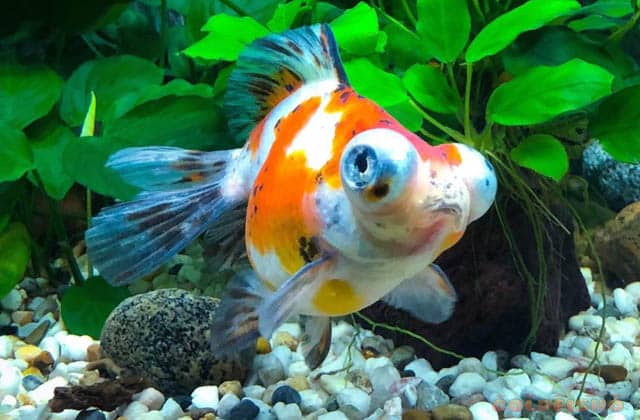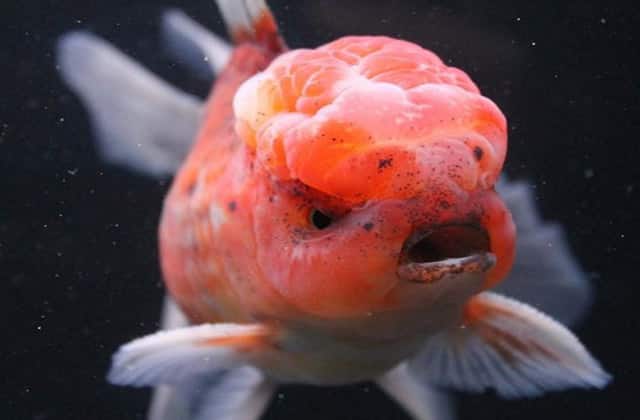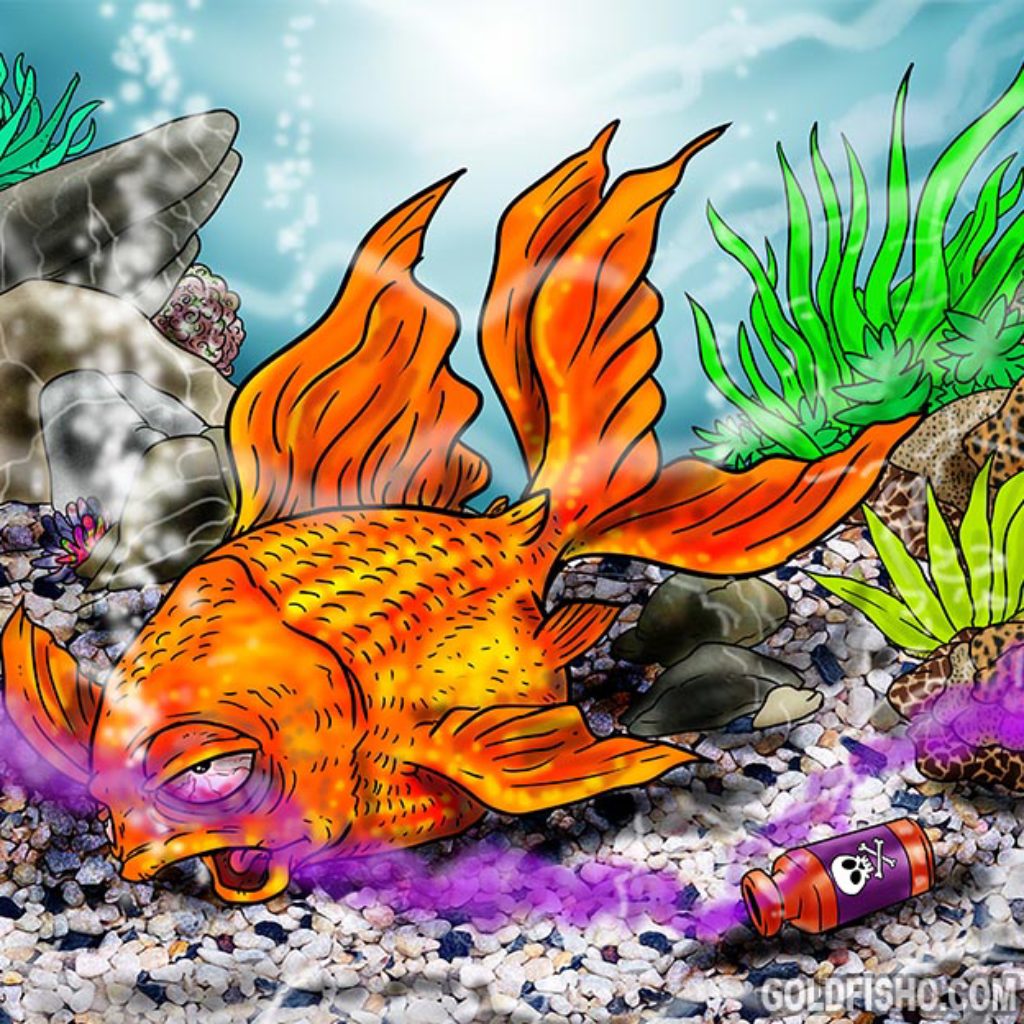Did you know that ammonia poisoning is common in new aquariums?
Ammonia: A Silent Killer of Goldfish
Ammonia Poisoning: A Guide to Understanding, Assessing, and Treating
Every fish hobbyist can attest to the frustrating dangers of ammonia in a fish tank.

It’s not a pleasant condition to resolve and can often be fatal for our beloved goldfish.
In looking at fish (as a whole) in their wild habitat, we see how open and vast the water in which they live.
Wild fish do not fall victim to the toxicity of ammonia.
This is because of the enormous amount of water dilutes ammonia.
When you have a fish tank, you are squeezing fish and the waste they produce into a minimal space.
In a confined amount of water, instead of dilution, it becomes concentrated.
We rely on filtration systems to filter toxins in the tank water.
However, along with a filter, we must also be diligent with tank maintenance to keep ammonia at a safe level.
Maintaining good water quality is the #1 preventative for ammonia poisoning and stress.
Did you know that every fish tank will, at some point,
experience an issue with ammonia levels?
Ammonia poisoning is the leading cause of death in goldfish.
What is Ammonia in a fish tank?
Ammonia is a byproduct that is produced from fish waste, fish breathing, and decaying organic matter (food, plants, algae.)
When these things build up in the tank water, it creates a toxic environment that is fatal to fish.

Dangerous ammonia accumulates as a result of failure to do weekly water changes and tank maintenance to include water testing.
The Nitrogen Cycle
To understand ammonia, it helps to recap on the nitrogen cycle.
Ammonia plays a leading role in the nitrogen cycle.
The nitrogen cycle not only exists in fish tanks but also on a grander scale with planet earth.
Plants, animals, pollution, weather, and bodies of water influence this cycle.
Waste in a fish tank goes through a 4-step breakdown process; the nitrogen cycle.
-
Fish waste and/or decaying plants/food/algae release AMMONIA, which is TOXIC.
-
Nitrifying bacteria (good bacteria) converts the ammonia to NITRITES which are TOXIC.
-
Nitrites are then converted (by nitrifying bacteria) into NITRATES which are LESS TOXIC.
-
Nitrates are absorbed by plants/algae. Water changes also reduce nitrates.

Share this Image On Your Site
<p><strong>Please include attribution to Goldfisho.com with this graphic.</strong><br /><br /><a href=’https://goldfisho.com/ammonia-poisoning-in-fish-symptoms-causes-treatment-and-prevention/’><img src=’http://goldfisho.com/wp-content/uploads/2019/08/the-aquarium-nitrogen-cycle.jpg’ alt=’Aquarium Nitrogen Cycle’ width=’660px’ border=’0′ /></a></p>
How dangerous is ammonia?
It goes without saying that ammonia is lethal to goldfish!
We can’t stress enough how vital it is that you maintain good water quality for the health of your fish.
Ammonia causes extreme distress and suffering for a fish.
Daily checks on your fish will help you to gauge unusual changes or behavior that may indicate ammonia present.
If you do notice these things, the first thing to do will be to test your water.
Ammonia levels should never be above zero!
We would recommend that you use a master test kit for your water testing.
- Contains one (1) API FRESHWATER MASTER TEST KIT 800-Test Freshwater Aquarium Water Master Test Kit, including 7 bottles of testing solutions, 1 color card and 4 tubes with cap
- Helps monitor water quality and prevent invisible water problems that can be harmful to fish and cause fish loss
- Accurately monitors 5 most vital water parameters levels in freshwater aquariums: pH, high range pH, ammonia, nitrite, nitrate
- Designed for use in freshwater aquariums only
- Use for weekly monitoring and when water or fish problems appear
Last update on 2024-07-24 / Affiliate links / Images from Amazon Product Advertising API
Ammonia is void of any smell or color.
You won’t know when it is present. Often if you begin to see your fish showing symptoms, it typically is too late for the fish.
Symptoms of Ammonia Poisoning
|
Fish gasping for air at the surface |
|
|
No appetite |
|
|
Lethargic |
|
|
Swimming Erratically |
|
|
Other Dead Fish |
|
|
Physical Appearance |
|
They lack movement and stay there.
Causes of Ammonia Poisoning
Several things produce ammonia in a fish tank.
- Fish waste
- Fish processing oxygen as water passes through their gills
- Decaying fish food left in the tank
- Decaying plants in the tank including algae
- Power outages
- Changing the filter
- A dirty filter
- Antibiotics in water compromises biofilter
When any of the above contributing factors are allowed to accumulate and build up in a tank, there will almost always be spikes in ammonia that are lethal.

Other reasons why you may get an ammonia spike in your tank would be because of:
The LEADING Causes of Ammonia Poisoning
1. Failure to do weekly water changes
We can’t stress enough how VITAL it is to have good water quality in a fish tank.
Fish will fail to thrive and live in poor water conditions.
Your biofilter converts ammonia to nitrates (the nitrogen cycle steps 1-3.)
However, it does not do anything for further filtering or converting nitrates.
This is where water changes come in.
To remove nitrates, you MUST do regular water changes.
Some plants and algae will absorb nitrates, but not near enough to make the water safe
2. Overcrowding
Putting too many goldfish in one tank leads to an overabundance of waste. Know the correct number of goldfish that can be safely placed into each specific size tank.
You can read more in-depth on the ratios of goldfish to tank sizes.
Tank shapes, size, and depth play a significant role in how many fish you can add.
- 5-gallon tank 1 goldfish
- 10-gallon tank 1-2 goldfish
- 20-gallon tank 1-2 goldfish
- 30-gallon tank 2-3 goldfish
- 55-gallon tank 4-5 goldfish
3. Not Doing Routine Water tests
It is important to conduct routine water tests. It’s always good to be proactive than reactive when it comes to our water babies.
Doing routine water tests will keep you abreast of the water conditions and if something starts to affect the cycle you can nip it in the bud early.
Treatment for Toxic Ammonia in the Fish Tank
After you have tested your water and confirmed ammonia levels, the following measures should be taken.
ACT QUICKLY because your fish’s life depends on it!
- Immediately transfer fish to a hospital tank.
- Do a water change on the ammonia-affected tank.
- Then retest water before adding fish back to the tank. Ammonia level should be zero.
- Increase the filter capacity of your biofilter.

Preventative Measures
- Change water at least once a week.
- Immediately remove decaying food or plant/algae matter.
- Avoid placing too many fish in the tank.
- Reestablish the biofilter after each treatment of medication. Medications kill the good bacteria that are needed to convert ammonia.
- Don’t overfeed your goldfish. This causes your fish to produce more waste.
- Have a hospital tank that is cycled and ready for any emergencies that come up.
Recommended Products for Ammonia
Prevention is your BEST tool to avoid ammonia poisoning.
One of the most important things to have for any tank maintenance is a tester kit.
Master test kits generally include ammonia testing.
However, you can purchase standalone ammonia testing kits.
Recommended Ammonia Test Kits
API Ammonia Test KIT
- Contains one (1) API AMMONIA 130-Test Freshwater and Saltwater Aquarium Water Test Kit, including 2 bottles of testing solution, 2 color cards and 1 test tube with cap
- Helps monitor and adjust ammonia level and prevent invisible water problems that can be harmful to fish
- Accurately reads ammonia 0 - 8 ppm (mg/L)
- Fish continually release ammonia and uneaten food and decaying organic matter also add ammonia to water
- Use several times a week when starting a new aquarium then weekly or when problem arise
Last update on 2024-07-22 / Affiliate links / Images from Amazon Product Advertising API
Why we like this product:
This test kit is exceptionally well-rated with outstanding customer reviews. It is easy to use, giving results quickly.
Pros:
- Excellent ratings and reviews.
- Includes everything you need to test the ammonia levels.
- Easy to use instructions and color chart.
- It can be used for both freshwater and saltwater tanks.
- Affordably priced.
Cons:
- Pay close attention to expiration date because once expired, it no longer works.
- If bottles of the testing solution are not shaken well, the test results will be inaccurate.
Tetra EasyStrips Ammonia Test Kit
- AMMONIA TESTING Regularly testing your water ammonia levels is critical to the success of your aquarium
- VERSATILE Can be used in both freshwater and saltwater aquariums
- CONVENIENT Just dip into water wait 10 seconds and read results
- COMPATIBLE WITH TETRA MY aquarium APP Get instant water care product recommendations based on testing results
- USAGE Use when setting up a new aquarium after water changes or as needed
Last update on 2024-07-22 / Affiliate links / Images from Amazon Product Advertising API
Why we like this product:
If you are looking for a convenient and quick way to test for ammonia, this is a great option.
Pros:
- Fast results with easy dip and read strips.
- Freshwater and Saltwater tanks.
- Excellent reviews and ratings.
- Easy to use.
- Comes in 3 different size options: 25 strips, 100 strips, or 200 strips.
- Affordably priced.
Cons:
- Some inaccuracy with test results.
- In comparison to API Ammonia Test Kit, this product’s test results were inaccurate. Many customers prefer the API kit.
Recommended Ammonia Detoxifiers
Beware that a detoxifier is just that, it is designed to detoxify ammonia that is present in tap water, not tank water.
When your tank is overcome with ammonia, you MUST do a water change instead of reaching for a detoxifier first.
Seachem Prime Conditioner
- POWERFUL TREATMENT: Seachem Prime is a complete and concentrated conditioner for both freshwater and saltwater fish tanks, working hard to remove chlorine and chloramine.
- REMOVER: Seachem Prime immediately and permanently removes chlorine and chloramine, successfully allowing the bio filter to remove ammonia, nitrite, and nitrate while they are detoxified for 48 hours.
- DETOXIFIER: Seachem Prime effectively detoxifies ammonia, nitrite, and heavy metals found in the tap water at typical concentration levels, providing a ideal environment for your betta, tetra, or other fish.
- USE: Use 1 capful (5 mL) of Seachem Prime for each 200 L (50 US gallons) of new or replacement water. For best results, add Seachem Prime to new water first. For exceptionally high chloramine concentrations, a double dose may be used safely. For smaller volumes, use 2 drops per gallon.
- SAFETY: In case of an emergency, the 5x dose of Seachem Prime may be used for both ammonia and nitrite. Use a ½ dose if the water temperature is > 30°C (86°F) and chlorine or ammonia levels are low.
Last update on 2024-07-22 / Affiliate links / Images from Amazon Product Advertising API
Why we like this product:
Although this product is a conditioner, it is ideal to use as a preventative measure to control ammonia. It is not designed to be used in an ammonia crisis, but rather for water changes. It detoxifies ammonia in tap water. This conditioner is the best on the market!
Pros:
- All in one conditioner that removes all harmful elements in tap water.
- Comes in various sizes.
- Easy to use.
- Freshwater and saltwater.
- Best conditioner on the market!
Cons:
- Not designed to be used to remove ammonia in a tank.
- Offensive odor.
API Ammo-Lock Ammonia Detoxifier
- Contains one (1) API AMMO-LOCK Freshwater and Saltwater Aquarium Ammonia Detoxifier 16-Ounce Bottle
- Detoxifies ammonia in aquarium water and tap water
- Works instantly to make aquarium water safe for fish
- Reduction in ammonia levels measurable on any API Test Kits
- Dose freshwater and saltwater every two days until ammonia is not detected
Last update on 2024-07-22 / Affiliate links / Images from Amazon Product Advertising API
Why we like this product:
If you have ammonia present in your tank water, this product will perform. However, you must do a water change and THEN add it to the water.
Pros:
- Ratings and reviews were all good.
- Affordably priced.
- Convenient and easy to use.
- Comes in various sizes.
- Freshwater and saltwater.
Cons:
- Intended use is AFTER a water change. There is a misconception that this can be added directly to a tank that is in ammonia crisis to remove ammonia.
Your Takeaway
Ammonia poisoning is a cruel thing for any fish to endure. It is also one of the most serious and irreversible conditions that affect fish.

We don’t want our little scaly pets to suffer, so it’s up to us to keep their water healthy and free of toxins.
Key things to remember…
- It is VITAL to stay on top of ammonia by doing regular water changes. Procrastination can kill fish.
- Test your water routinely.
- Be prepared for an ammonia crisis by having a hospital tank established.
- If you have ammonia present, ACT QUICKLY!
Did we miss something? Let us know in the comments…






